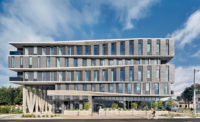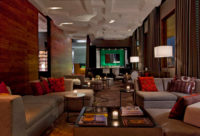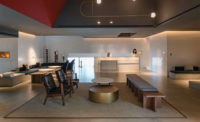A river and a 10-lane expressway separate the Loop, Chicago’s high-rise downtown, from the Fulton Market area, a gritty low-rise backwater to the west whose brick warehouses used to provide storage for wholesale-food businesses like meatpacking, in a city Carl Sandburg described in 1914 as “hog butcher for the world.”
A century later, the hog butchers are long gone, replaced by hipsters living in condo lofts, techies working at Google, foodies flocking to upscale restaurants, and fashionistas navigating the cracked sidewalks in 6-inch heels. The streetscape is scruffy, but it’s only a 10-minute walk from the Loop, so developers have been descending into the area en masse, and today 52 projects are either under construction or on the drawing board. Many are for hotels, which the rapidly gentrifying neighborhood needs, including new outposts for Hyatt, Hoxton, Nobu, and Equinox. Last August, the Portland-based boutique hospitality chain Ace opened the $44 million, 159-room Ace Hotel Chicago, designed by Chicago-based GREC Architects with interiors by Los Angeles COMMUNE Design, firms that had previously collaborated on the Ace in downtown L.A.
Additional Content:
Jump to credits & specifications
Trying to fit into a historic cityscape can lead architects into pastiche, but GREC sidestepped this trap with a sensitive modernist intervention. “Our practice has long been rooted in the principles of early Modernism,” explains principal Don Copper. “A design language inspired by the legacy of the Bauhaus and Mies van der Rohe yet informed by the local warehouse vernacular seemed harmonious with the Ace brand, compatible with the area’s industrial aesthetic, and firmly rooted in Chicago’s architectural continuum.”
The Ace is situated directly opposite Google—a company with enough clout to demand a clause in its lease that stipulated the construction of a hotel across the street. The property was controlled by the same developer that built the tech giant’s offices in a renovated 1920s cold-storage facility. Ace was selected in part because of its track record transforming emerging neighborhoods.
The 262-foot-long hotel site carried three restrictions. Google’s views of the Loop skyline were protected by a height limit that applied to most of the street frontage, leaving only 54 feet at the north end for construction higher than four stories. The area is landmarked, so the 45-foot-wide, two-story redbrick facade of a former cheese warehouse had to be retained, the only historic remnant on the site. Finally, the district’s design regulations stipulated a continuous street wall.
GREC responded to these constraints with a hybrid building designed to look like three smaller ones. At one end, they created a fourstory structure behind the historic facade and clad it in matching red brick. At the other end, beyond the boundaries of Google’s height restriction, they built a seven-story volume with meeting rooms, a bar, and lounges on the top two floors. Both of these wings have retail space at grade and guest rooms above. In between, the architects inserted a 163-foot-long, four-story span topped by a roof terrace. Set back 20 feet from the property line, this lean central section contains the hotel lobby and public spaces, which are visually extended by an outdoor patio. This lively gathering place, for hotel guests and casual drop-ins alike, is enclosed by an open screen comprising steel columns and beams with a brick base and spandrels—an airy partition that also provides the required street wall.
The architects reinforced the three-part massing by using different materials for each portion of the building. “This creates a more varied streetscape,” says Copper. The new floors visible above the historic facade not only replicate the original red brick but also the punched windows. The seven-story wing is clad in creamy white brick, with ribbon-like horizontal fenestration on the side elevation and a graphic grid of floor-to-ceiling industrial sashes on the front, which recalls Mies van der Rohe’s 1939 Minerals and Metals Building on the Illinois Institute of Technology campus a few miles away. The facade of the lower, central wing features a steel frame filled with ganged casements and charcoal brick spandrels.
The interiors are a nuanced mix of high and low that Commune’s cofounder Roman Alonso describes as “polished but comfortable.” The glazed lobby, brilliantly sunny by day, merges seamlessly with a restaurant, bar, and coffee shop on a continuous floor of charcoal terrazzo, under ceilings paneled in plywood and fiberboard. The reception desk and bar are finished in linoleum and brass. In the guest rooms, exposed concrete ceilings contrast with plush draperies and eclectic custom furnishings, while bathrooms and storage are wrapped in crisply detailed plywood. Alonso says the design is “a little more grown-up and refined” than Commune’s previous work for Ace. Unlike some hipster hostelries that feel like nightclubs, this one is refreshingly light, airy, and calm.
Ace has established its brand primarily through edgy makeovers of historic buildings. Its Chicago venture is only the second that’s mostly new construction, but its bold, rigorous formalism, inspired by the local Miesian heritage, was just what Kelly Sawdon, Ace’s chief brand officer, wanted—“a modern synthesis of functionality, art, and design in the legacy and spirit of Chicago”—or, as Alonso puts it, “Mies does Ace.”
CreditsArchitect: GREC Architects— Don Copper, principal; Ryan von Drehle, Nate Casteel, project architects
Interior designer: COMMUNE Design
Engineers: Forefront (structural); WMA Consulting Engineers (m/e/p/fp); Spaceco (civil)
Consultants: Site Design (landscape); Integral Consulting (enclosure systems); Charter Sills (lighting); Shiner + Associates (acoustics); Veneklasen (it/av)
General contractor: Power Construction |
SpecificationsGlass Oldcastle BuildingEnvelope
Windows Wausau; Winco
Masonry Summit Brick, Lakewood Brick, Ragland Clay Products
Metal Benchmark Steel, Euroclad (Millennium Tiles); Coast to Coast Manufacturing (steel storefront) |

















Post a comment to this article
Report Abusive Comment